Exploring the Rich History of Rome
The history of Rome presents an intriguing exploration spanning more than 2,500 years. As the heart of one of the most powerful empires in human history, Rome's influence on politics, culture, architecture, and religion can still be seen today. Founded in 753 BCE by the mythical brothers Romulus and Remus, this city emerged as a crucial hub of authority and creativity, playing an influential role in the development of Western civilization while serving as the capital of the Roman Empire.

Presently, Rome stands as a lively contemporary city while simultaneously serving as a historic gallery, where ancient structures harmoniously coexist with Renaissance buildings and Baroque water features. The city offers an unparalleled experience for those interested in exploring historical landmarks like the Colosseum, the Roman Forum, and St. Peter's Basilica. Each site tells a unique story of Rome's development and its lasting legacy on world history.
The Foundation of Rome
The legendary beginnings of Rome are intertwined with the story of Romulus and Remus, twin siblings who were left to fend for themselves at birth and nurtured by a she-wolf. According to legend, Romulus later killed his brother and founded the city on Palatine Hill. While this story may be more fiction than fact, archaeological evidence suggests that settlements in the area date back to around 1000 BCE.
The early Romans drew inspiration from nearby cultures, notably the Etruscans and Greeks. The early Romans achieved impressive advancements by integrating various architectural styles, spiritual traditions, and writing methods from neighboring civilizations. The Roman Republic was established in 509 BCE following the overthrow of the last Etruscan king, marking the beginning of Rome's expansion across Italy.
The Roman Empire: Power and Glory
The transformation from Republic to Empire came with the rise of Julius Caesar and Augustus, his adopted heir. Under Augustus' rule in 27 BCE, Rome entered a period of unprecedented peace and prosperity known as Pax Romana. This era saw significant advances in engineering, law, military strategy, and governance.
- Architecture: The Romans were master builders who constructed iconic structures such as the Colosseum, Pantheon, and aqueducts that transported water into the city.
- Military: The Roman legions were highly disciplined and efficient, enabling them to conquer vast territories across Europe, North Africa, and parts of Asia.
- Roman law served as the cornerstone for contemporary legal frameworks globally, shaping principles such as the right to a jury trial and the presumption of innocence until guilt is established.
At its height in 117 CE under Emperor Trajan, the Roman Empire controlled approximately 5 million square kilometers (1.9 million square miles) of land. Its influence extended far beyond its borders through trade networks that connected distant regions like Britain to India.
Religion: From Paganism to Christianity
Rome was initially polytheistic, worshipping a pantheon of gods borrowed from Greek mythology. Jupiter (the Roman equivalent of Zeus), Juno, Mars, and Venus were among the most prominent deities. Religious rituals were intricately linked to civic life, with temples scattered throughout the region and ceremonies performed to seek divine blessings for military endeavors or political choices.
In the 4th century CE, during the reign of Emperor Constantine I, Christianity started to spread throughout the empire. In 313 CE with the Edict of Milan, Constantine legalized Christianity after centuries of persecution against Christians under previous emperors. In the year 380 CE, during the reign of Emperor Theodosius I, Christianity was formally recognized as the state religion of the Roman Empire.
The Fall of Rome
The decline of Rome is often attributed to a combination of internal strife and external pressures. Corruption within government institutions weakened administrative efficiency while economic troubles strained resources needed for defense. Meanwhile, barbarian invasions from groups like the Visigoths sacked Rome in 410 CE.
- Political Instability: A series of weak emperors failed to maintain control over distant provinces.
- Economic Challenges: Inflation and heavy taxation contributed to social unrest among citizens.
- Invasions: External threats from Germanic tribes disrupted trade routes while pillaging cities along Rome’s borders.
In the year 476 CE, widely regarded as a transformative moment in history, Odoacer, a chieftain of the Germanic tribes, deposed the last Roman emperor in Western Europe. It’s important to note that while Western Rome fell into decline during this period (often called Late Antiquity), Eastern Rome (or Byzantium) continued to flourish for nearly another thousand years until Constantinople fell in 1453.
Rome Today: A Blend of Past and Present
Modern-day Rome is a testament to its enduring legacy. Visitors can walk through millennia-old ruins one moment before stepping into lively piazzas bustling with restaurants and shops offering contemporary Italian cuisine or fashion. The Vatican City (an independent city-state within Rome) serves as both an artistic treasure trove with works like Michelangelo’s Sistine Chapel ceiling frescoes as well as headquarters for global Catholicism.
Rome's transportation system has made remarkable strides since its ancient beginnings. The charming cobblestone streets contribute to the city's allure, while the introduction of modern metro lines enhances accessibility. Tourists can now effortlessly navigate historical landmarks alongside contemporary conveniences, such as hotels, cafés, restaurants, and gelato shops, all found throughout the Centro Storico area. This unique blend of culture, gastronomy, heritage, and leisure creates a truly unforgettable experience for anyone seeking an engaging getaway.
The rich history embedded throughout everyday life makes visiting unforgettable enriching rewarding whether first-time travelers longtime aficionados alike fascinated past present blended beautifully together timeless charm culture flair sophistication unmatched globally recognized destination stands apart others many reasons primarily historic significance woven fabric shaping
This article was generated by AI